Iliman Ndiaye has become integral to Sheffield United since making his debut for the club back in 2021. The Senegalese forward has rightly received many plaudits for his performances, which were vital to United’s promotion back to the Premier League.
Ndiaye’s remarkable rise proves the importance of clubs being patient with their young players. He experienced a diverse journey at youth level, starting at his hometown club of Rouen, then progressing through the Marseille youth academy, and finally joining AS Dakar Sacré-Cœur in Senegal. In 2016, Ndiaye ventured into English football by signing with Boreham Wood, where he honed his skills for three years, including a loan spell with Hyde United, before ultimately making the move to Bramall Lane.
As the summer transfer window rolls on, transfer rumours link Iliman Ndiaye with a move back to Ligue 1 side Marseille and Everton, who survived relegation by the skin of their teeth last season. Of course, Paul Heckingbottom and Sheffield United would prefer not to lose their star man ahead of what could be a critical season. With the view that he will be absolutely vital to their Premier League campaign, the club have reportedly offered him a new contract to ward off any more potential suitors.
In this tactical analysis and scout report, we will look at why clubs are chasing Ndiaye and how he fits into Paul Heckingbottom’s tactics. We will understand what makes him such an essential player for the team and if Sheffield United were to lose their talisman, who could replace him at Bramall Lane.
Iliman Ndiaye’s role in Sheffield United’s tactics
To begin this analysis, let’s look at Sheffield United’s tactics. Typically Paul Heckingbottom favours a 3-5-2 formation, with Ndiaye as one of the front two. Whether he plays on the strike force’s left or right varies, mainly depending on who the opposition is and who will be his partner in attack. That being said, Heckingbottom was forced to make some slight adjustments to his tactical set-up towards the end of the season.

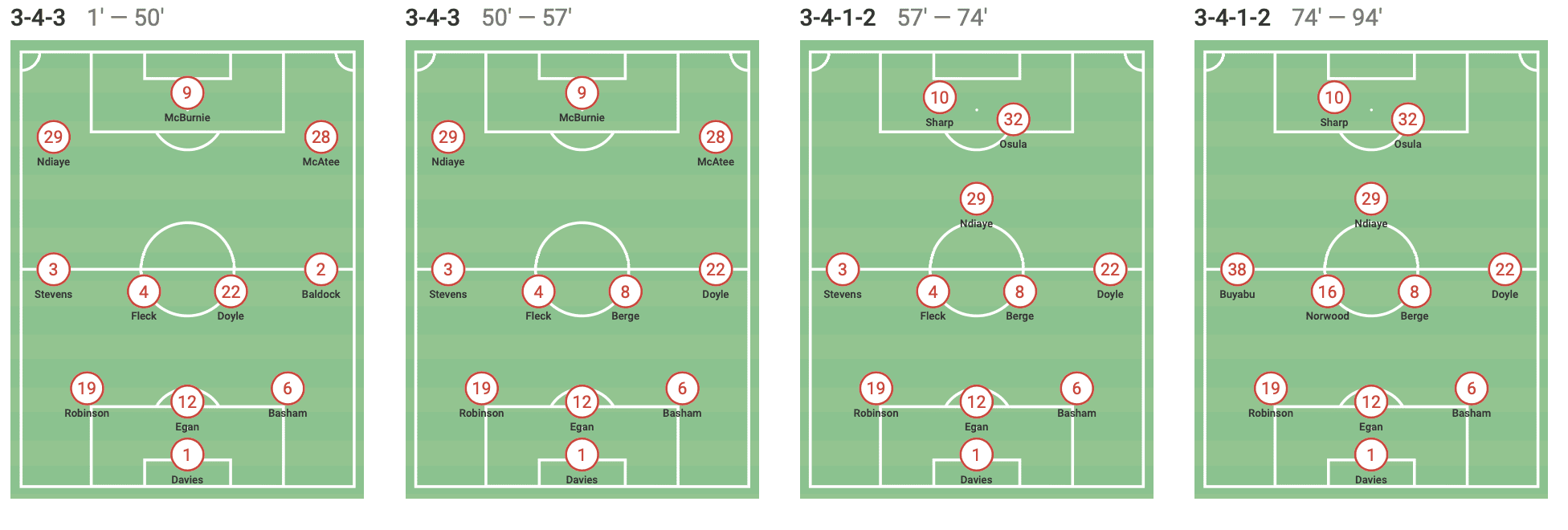
The graphics above show us how Sheffield United’s shape would change throughout games, and we can see that often involved Ndiaye’s role changing as well. In the top graphic from the game against Preston, we can see that Ndiaye began playing in the number 10 role and, as the game evolved, moved to play in a front two alongside Jebbison.
Additionally, we can see that in the following graphic, taken from the game against Birmingham, Ndiaye began on the left of a 3-4-3 formation, which then moved to a 3-4-1-2 formation that saw him occupying the number 10 role again.
Intelligent body orientation
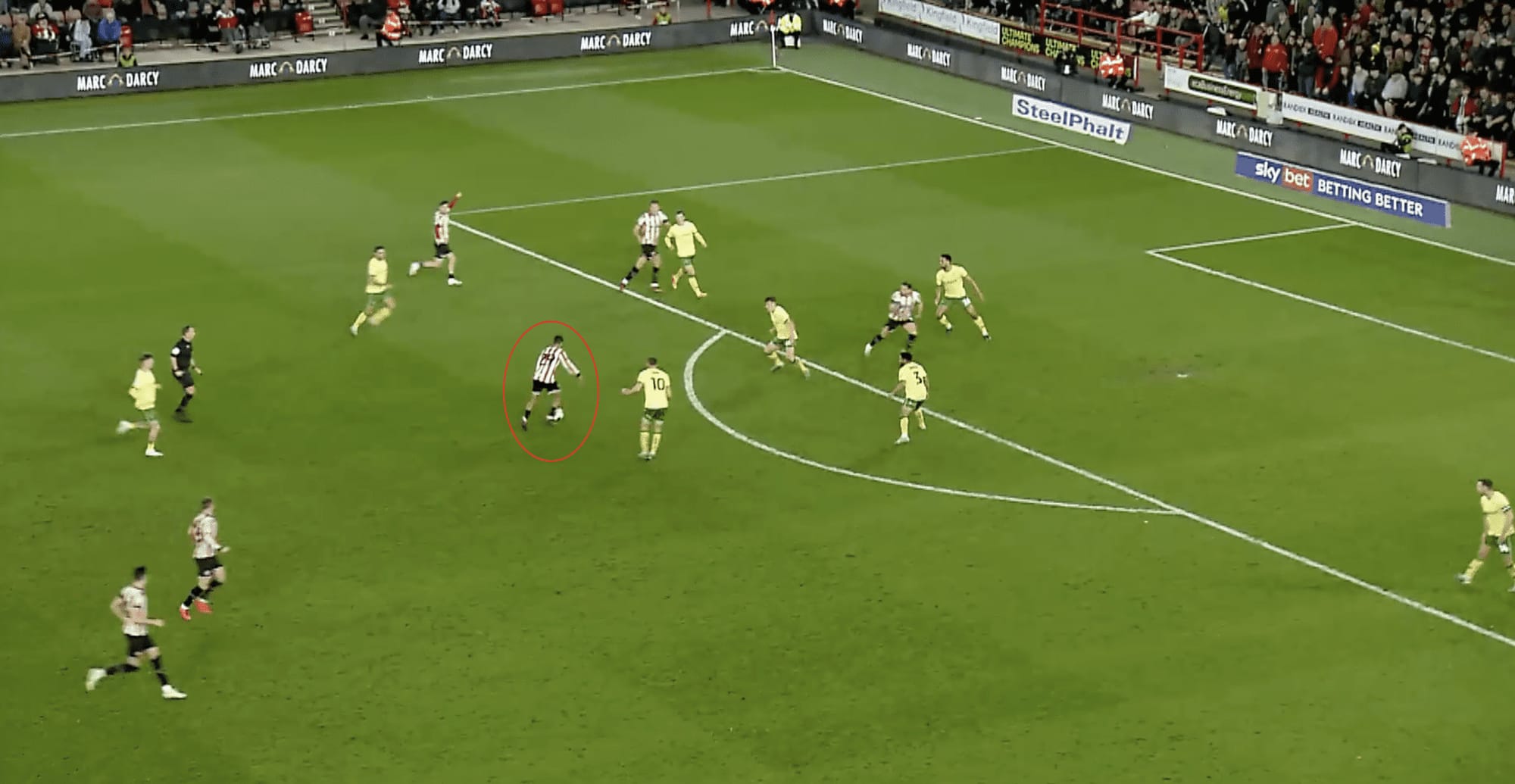

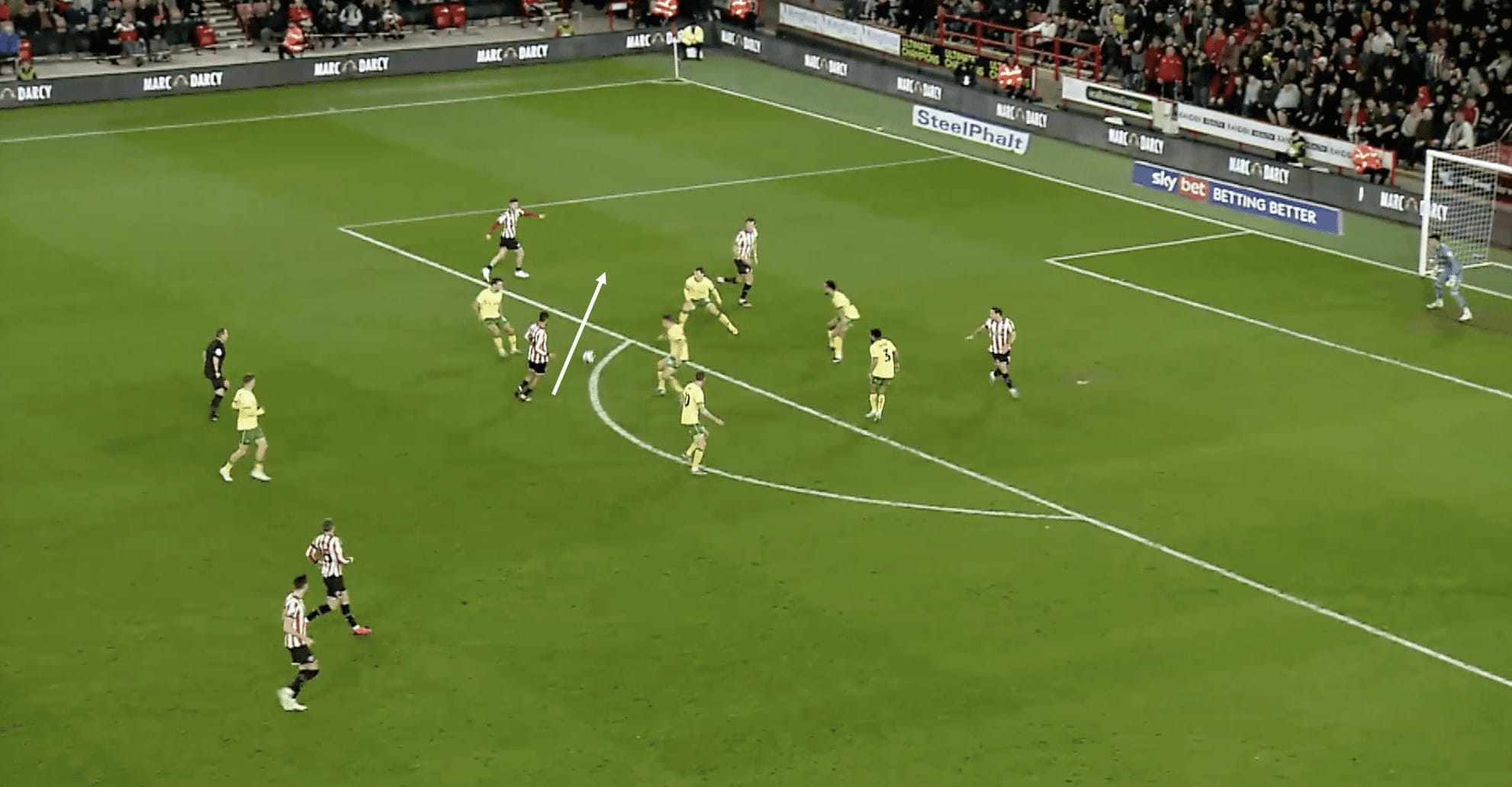
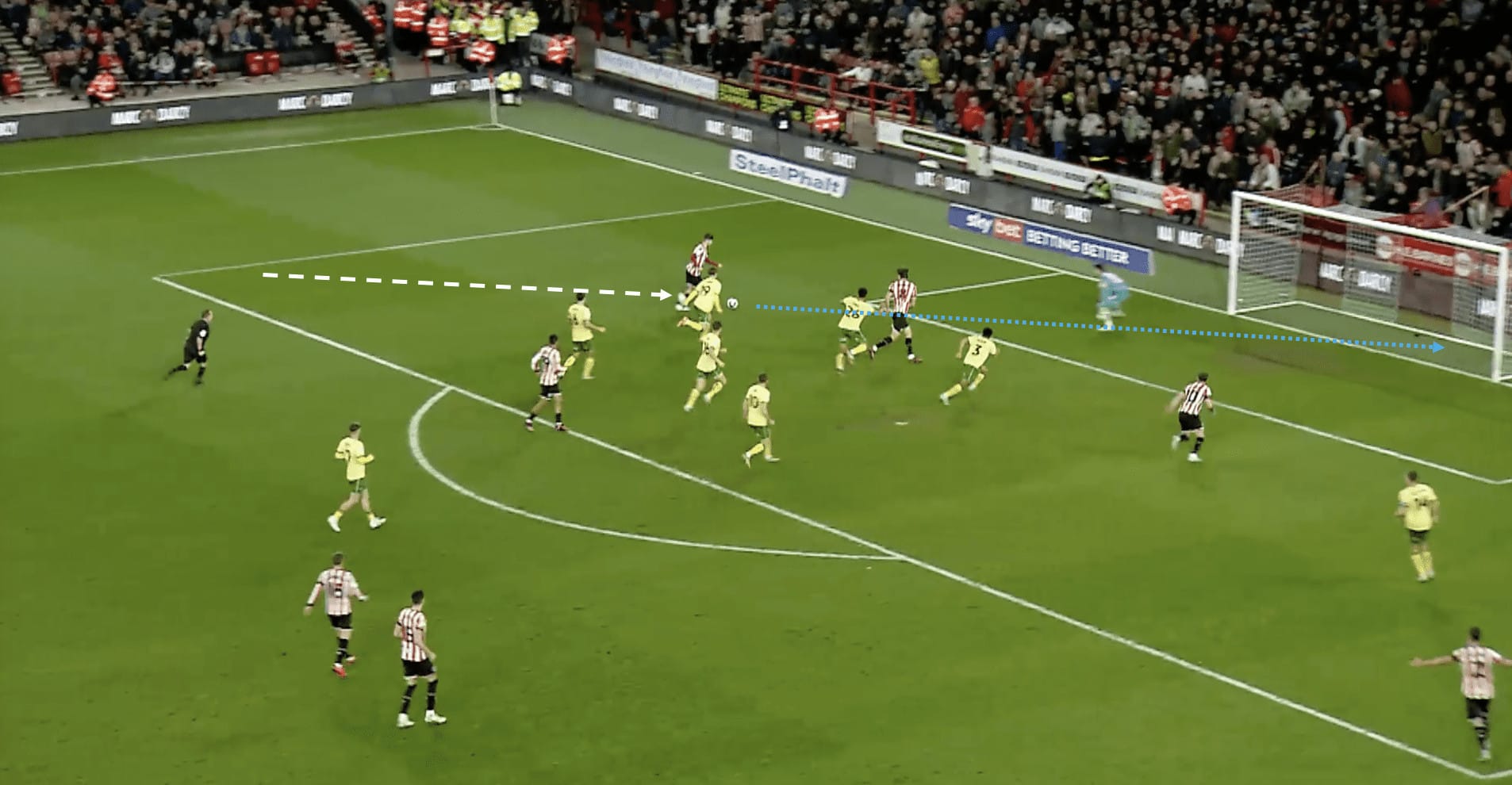
Fast, skilful, intelligent and dynamic are all words we associate with Iliman Ndiaye, and we will cover those aspects of his game later in this scout report. To begin this analysis, though, we will highlight one of the more subtle aspects of his game, yet one of the most effective. The Blades forward is incredibly adept at using his body orientation and positioning to give himself and his team an advantage in the attacking phase.
We can see this in the images above; Ndiaye shaps his body as though he will take a left-foot shot from the edge of the penalty area. This completely fools the Norwich defender; as we can see in the second image, he makes a move to his left ready to block the shot. Ndiaye then plants his left foot and plays a through ball with his right into the path of Ben Osborn, who places the ball into the far corner of the net, beyond the goalkeeper.
By making subtle adjustments to his body positioning, the Sheffield United forward can deceive defenders and create space for himself. Changing the angle of his body or shifting his weight can lead defenders to anticipate a different move, giving the forward an advantage to exploit gaps in the defence.
Dynamic in attack
One of the words used previously in this scout report to describe Iliman Ndiaye is ‘dynamic’. What we mean by this is that the 23-year-old is very often the player who makes things happen for Sheffield United, both on and off the ball.
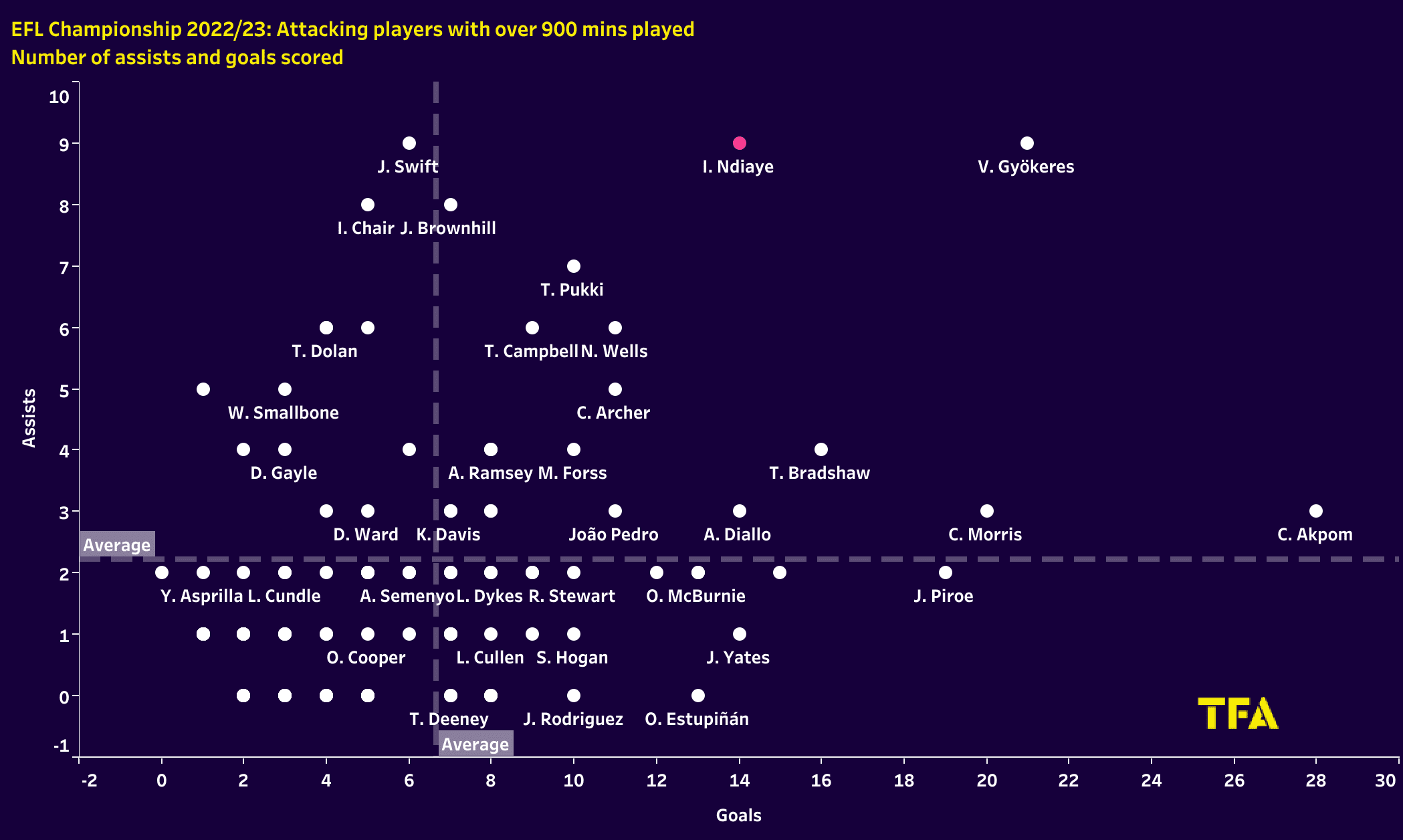
Let’s focus on his goal contributions for this section of the analysis. Ndiaye topped both the goalscoring and assist charts for The Blades last season. He ended the 2022/23 campaign with 14 goals and nine assists. If there was any doubt about why he is so vital to this team, his goal contributions alone are explanatory.
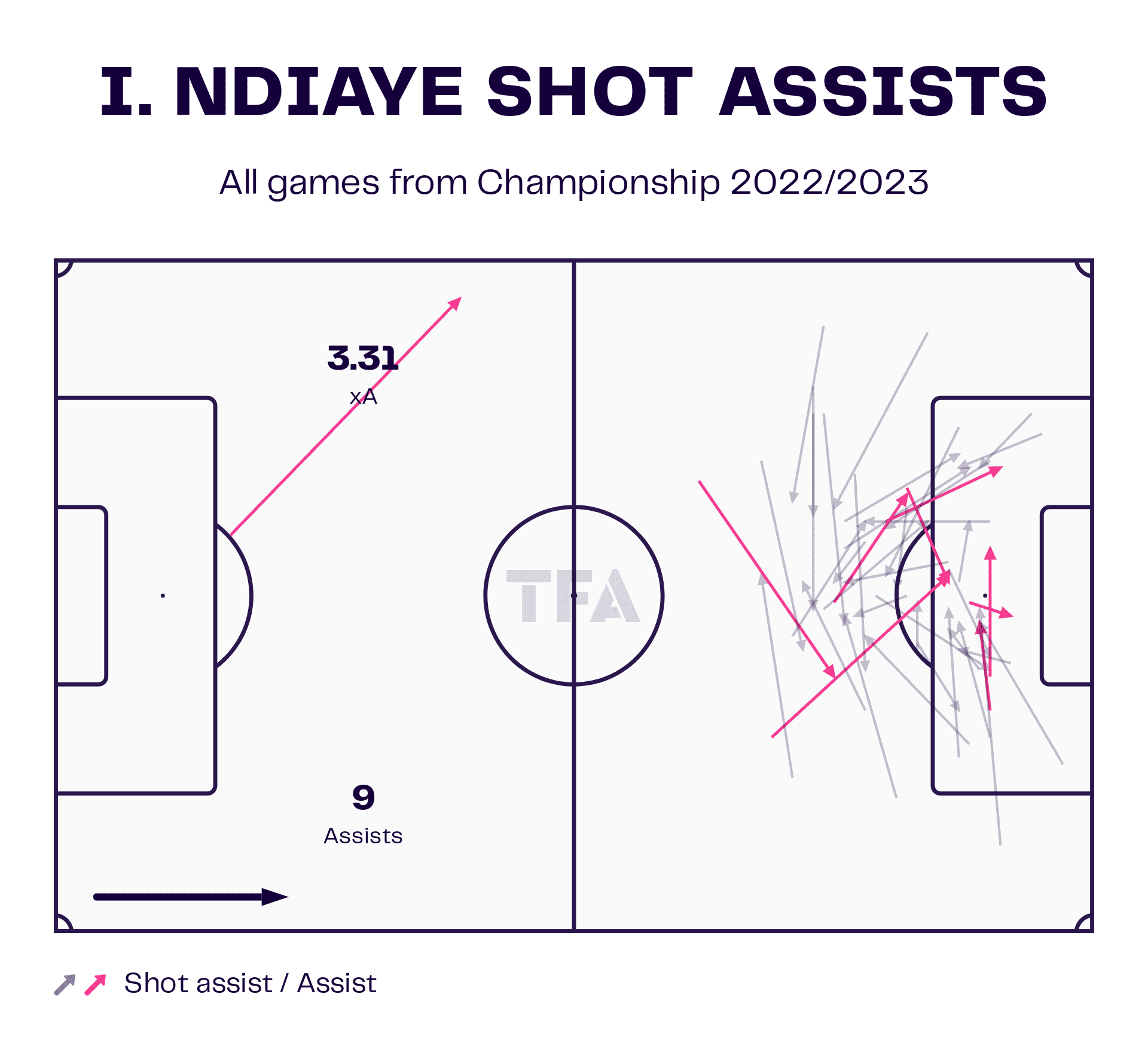
From the data visual above, we can see that Ndiaye’s nine assists came from an xA of 3.31, which represents a significant overperformance in this metric. Of course, it is essential to remember that many factors could influence this. For example, on the one hand, it can mean the player showcases exceptional creativity and vision. Such individuals can see and execute passes that surpass the expectations of standard chances, leading to more assists to his name.Moreover, we mustn’t forget that Ndiaye’s Sheffield United teammates may play a vital role in this scenario. His outperformance of xA could also result from his teammates having a higher conversion rate than average. When his teammates run onto his passes, they could be more adept at finishing those opportunities, contributing to more assists for Ndiaye.
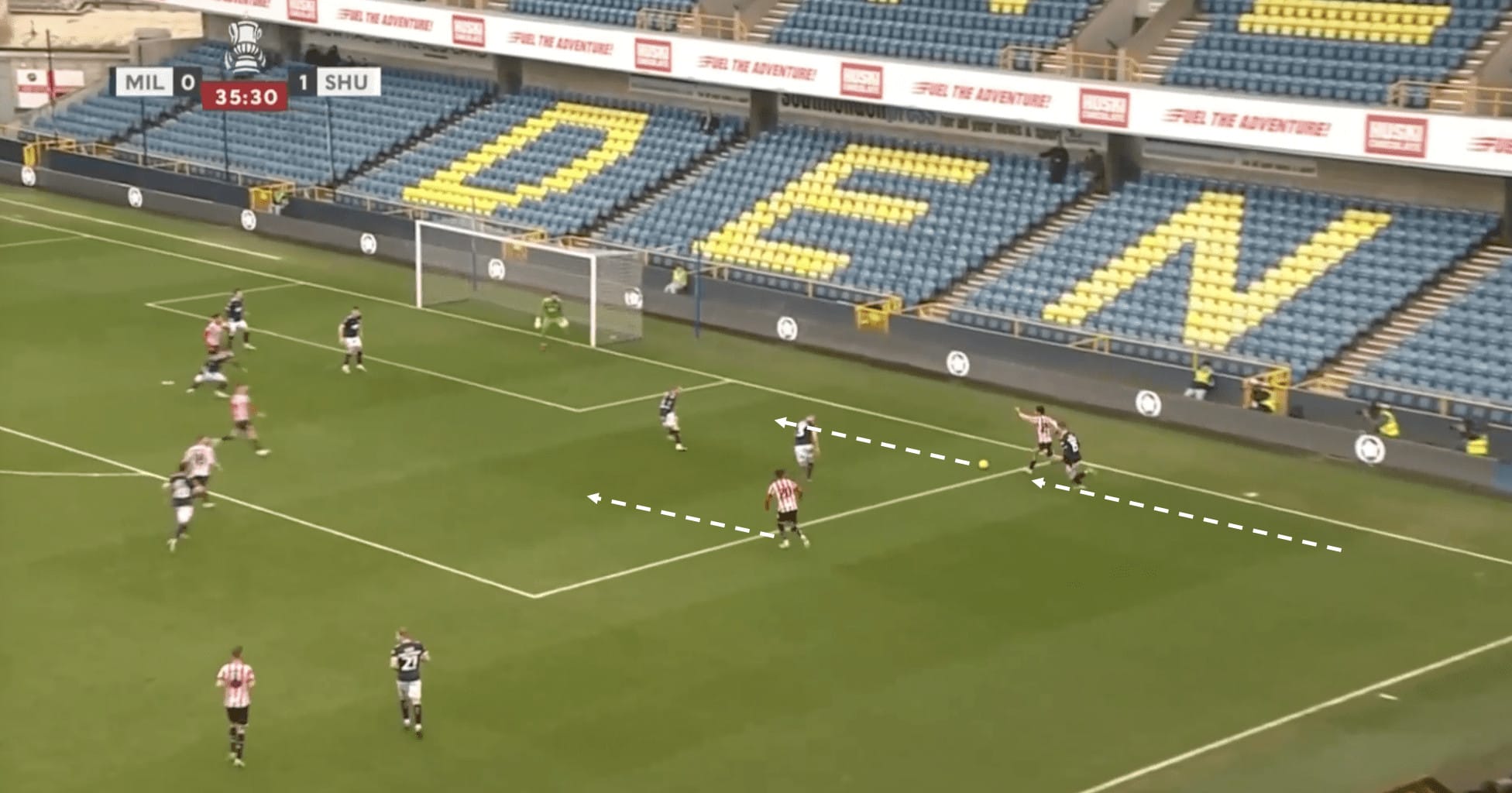
For instance, Ndiaye uses his skill and pace to beat his man on the right flank for Sheffield United. He then carries the ball into the penalty area.
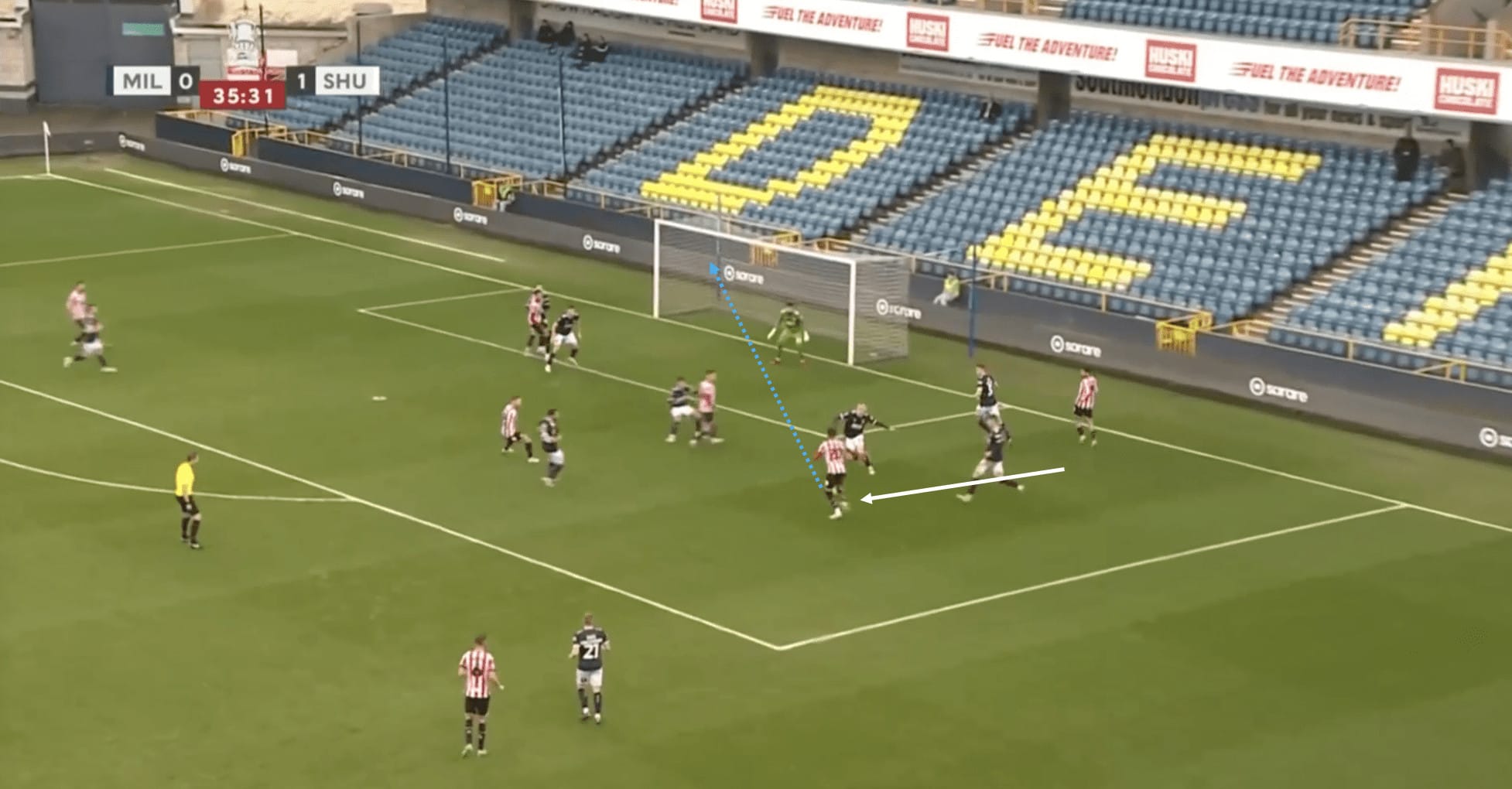
Most will have expected him to play a pass into the six-yard area, across the face of the goal, in the hope that one of his teammates will get ahead of their maker and be able to tap the ball into the net. Ndiaye has other ideas; he deftly passes the ball into the path of Jayden Bogle, who hits a powerful shot beyond the goalkeeper.
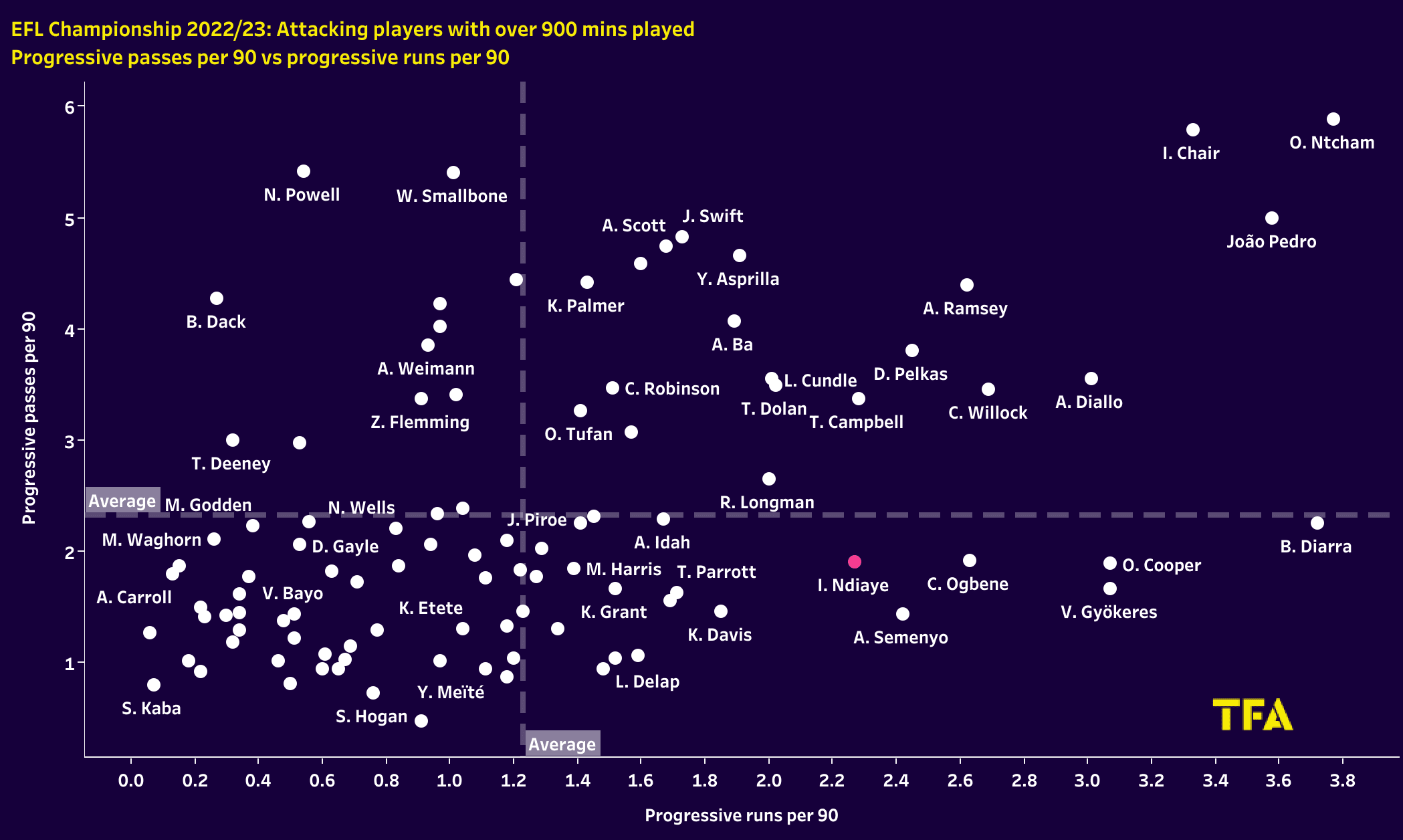
If we look at Ndiaye’s ball progression, we can see from the above data that he averaged 1.9 progressive passes per 90 and 2.27 progressive runs per 90 in the EFL Championship last season. This places him above average in terms of progressive runs and below average in terms of progressive passes, which is no real surprise given that Sheffield United are not a team that dominates possession, as they averaged 50.49% per 90 throughout the season.
Ndiaye’s ability to progress the ball effectively means the team can gain several key advantages. Firstly, they can bypass opponents and break through defensive lines, gaining valuable territory and reaching more dangerous areas on the field. Moreover, good ball progression provides him with increased passing options. As he carries the ball into advanced positions, he forces defenders to engage and close them down, which opens up space for teammates to exploit.
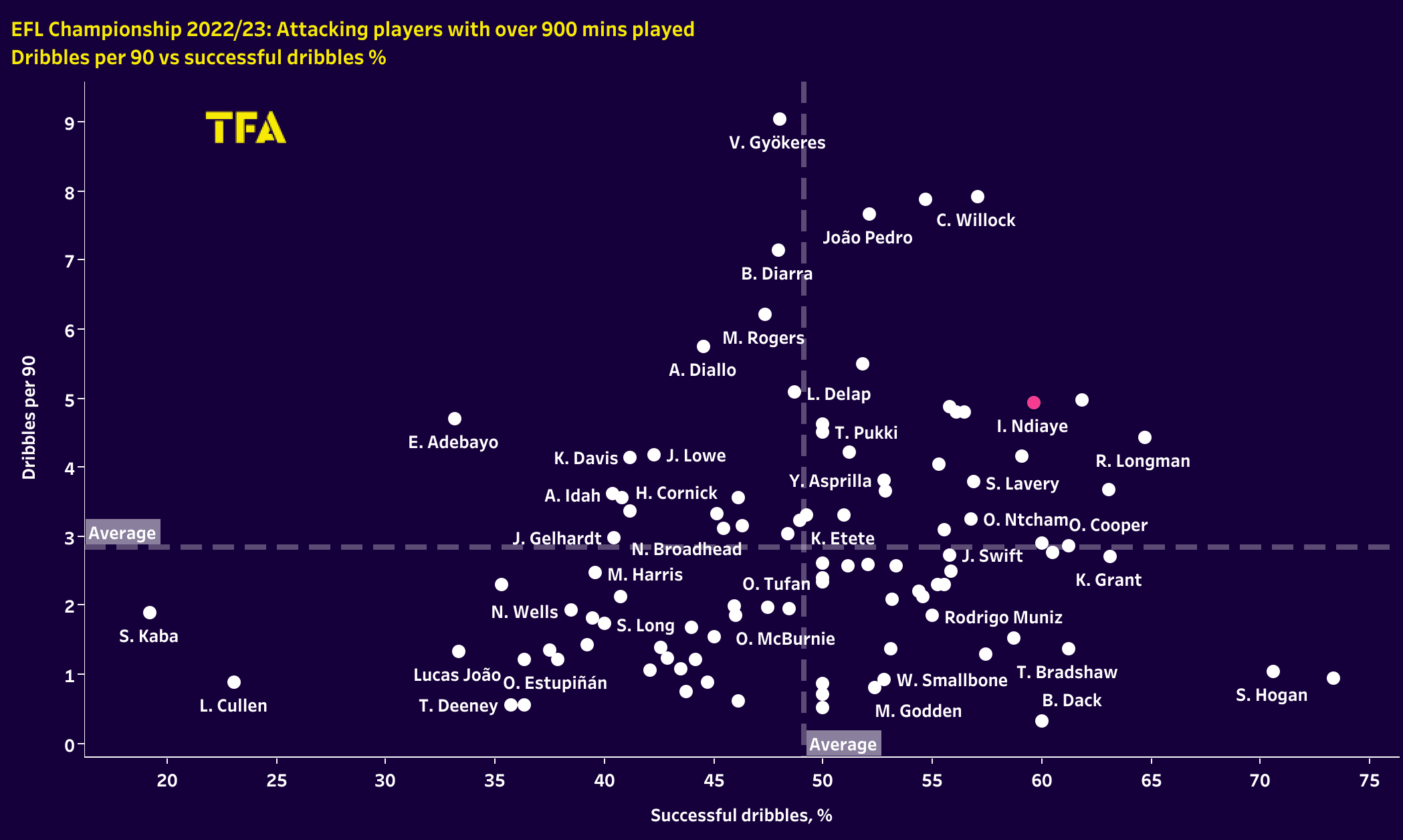
Let’s take a close look at Ndiaye’s dribbling ability. We can see from the data visual above that he averaged 4.94 dribbles per 90 last season, with a success rate of 59.63% which means he performed above average compared to the players in the sample (which consists of attacking players who played over 900 minutes of football).
Ndiye’s dribbling skills enable the talented forward to navigate the opposition’s defence skillfully. When facing tight defensive lines, he can call upon his abilities to change direction, perform feints, and execute quick turns, making it difficult for defenders to predict his next move.
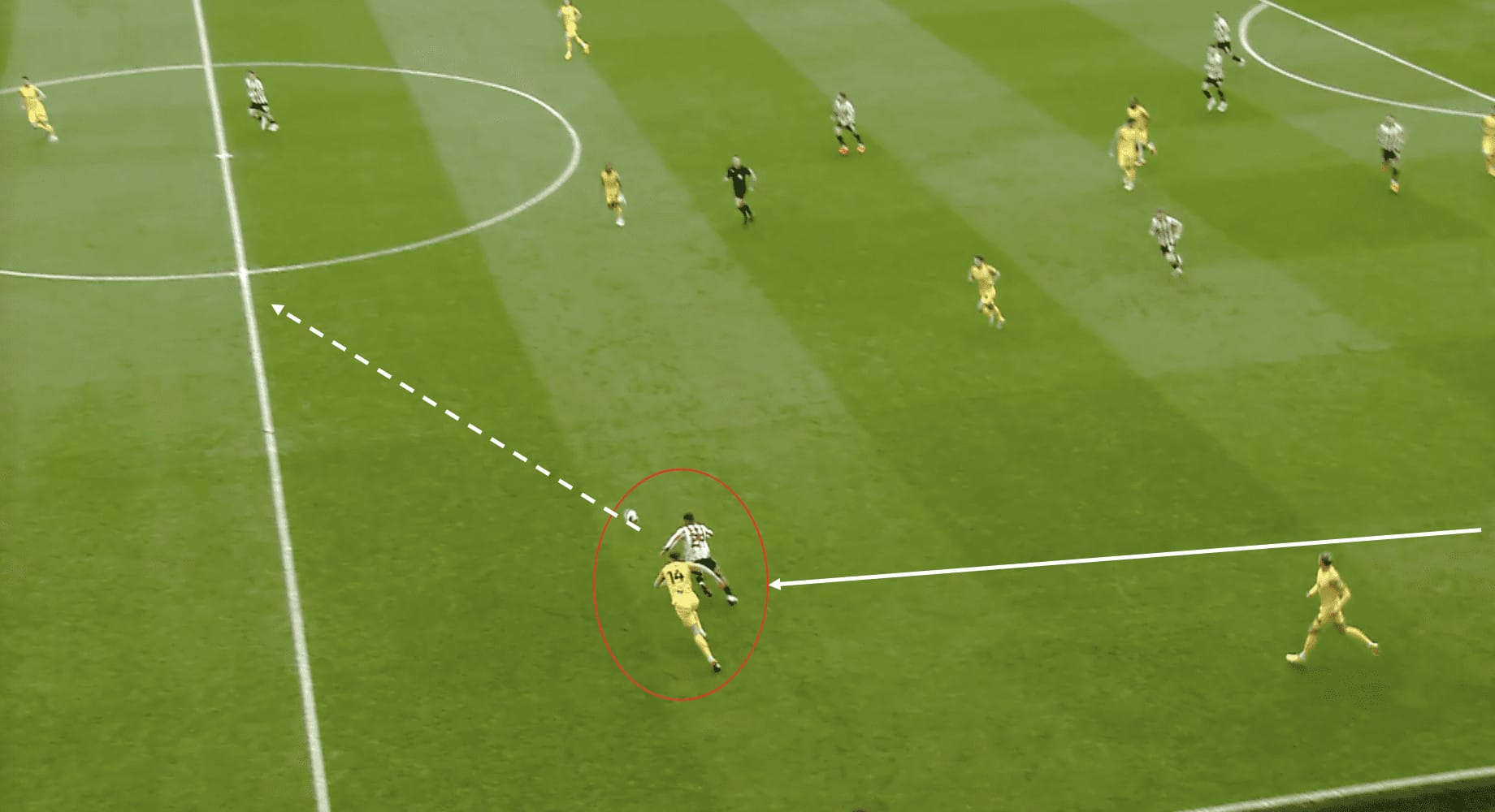
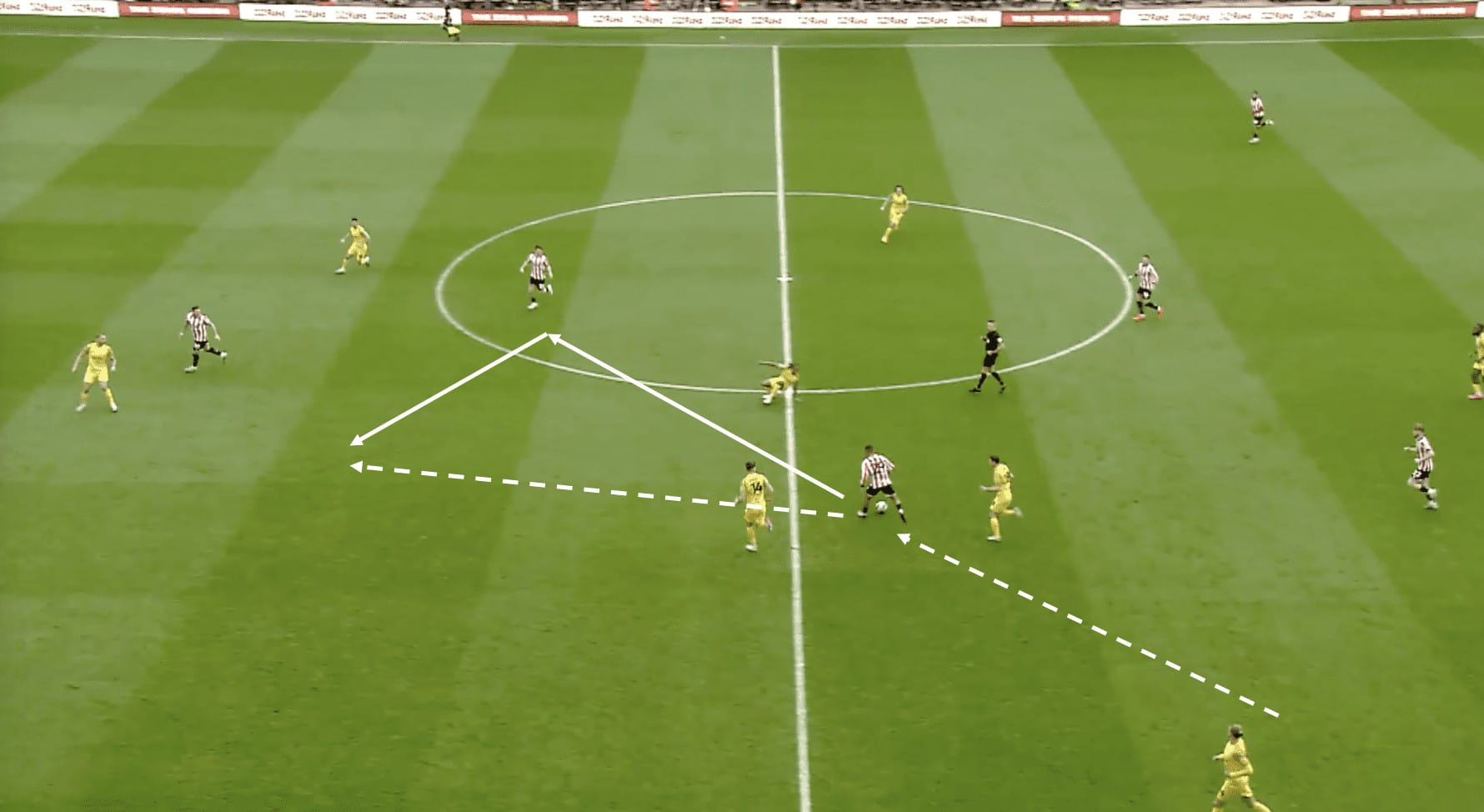
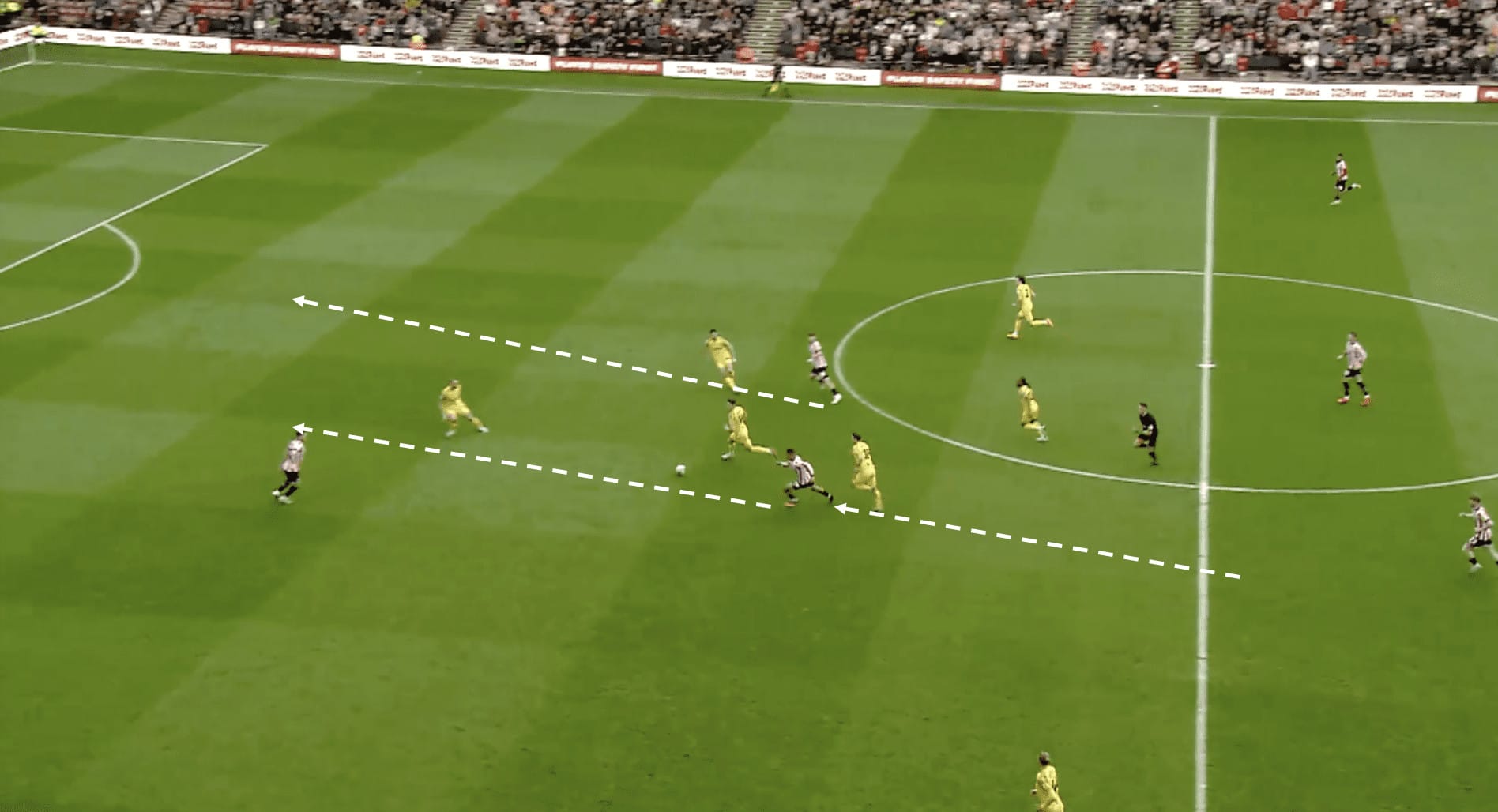
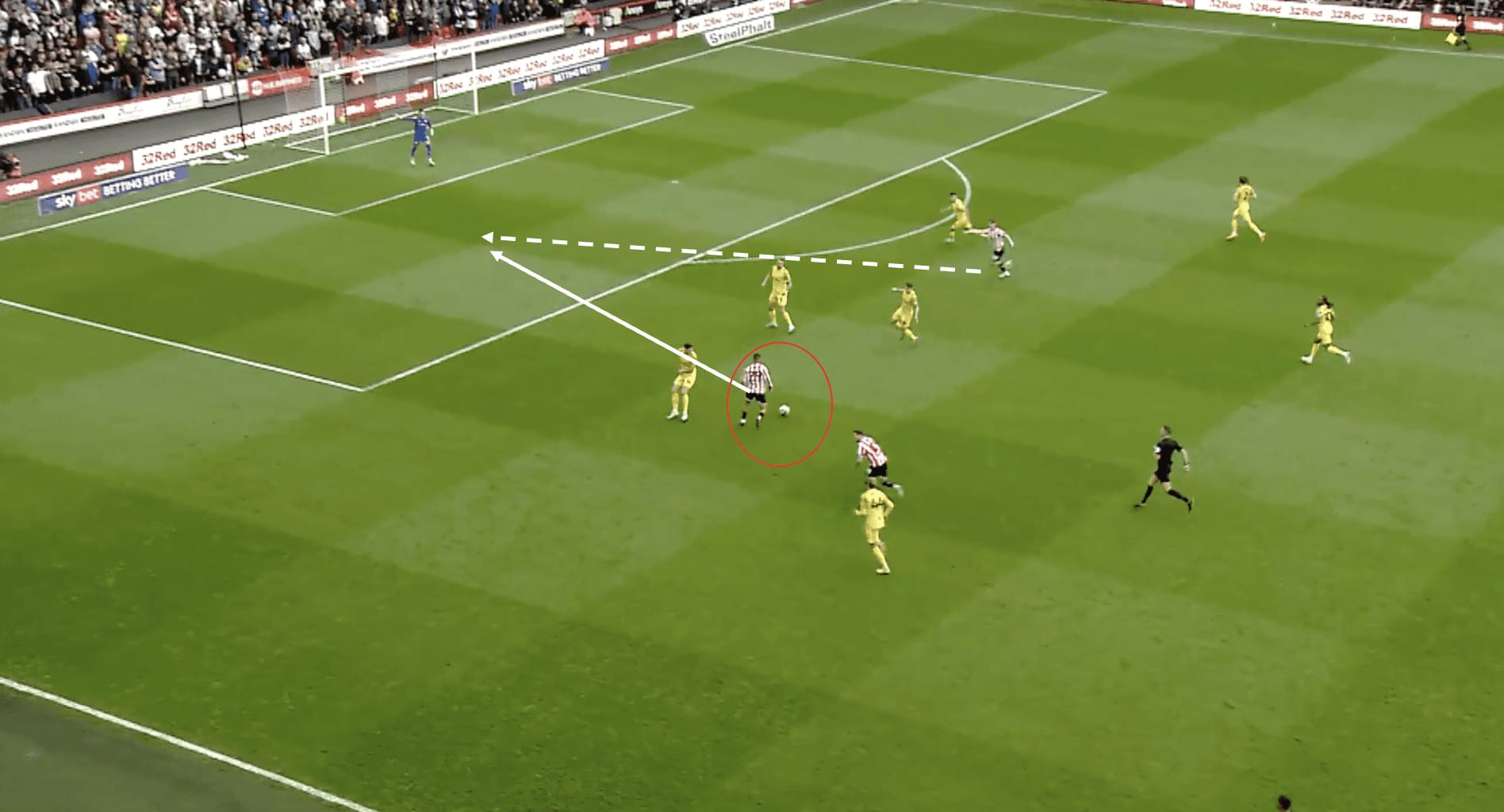
Additionally, Ndiaye’s ball-carrying abilities play a vital role in his ability to act as a link-up man for Sheffield United. In this sequence of images, Ndiaye uses his body positioning and excellent first touch to take the ball away from the defender. Upon the opposition players surrounding him, the Sheffield United man then plays a pass to his teammate, but that doesn’t mean Ndiaye’s participation in this attack ends.
He uses his speed to breeze past the opponents and receives a pass played into his path from his teammate. Then, he’s off. Using his pace and close control, he carries the ball to the edge of the area and then has the vision to see that his teammate is looking to make a run in between the two centre-backs and can play a nicely weighted pass into the penalty area. This Sheffield United attack was built by Ndiaye’s determination on the ball, his ball-carrying abilities, and his willingness to make things happen in the attacking third.
Off-the-ball impact
We have talked about Ndiaye’s on-the-ball abilities and why they are vital to Sheffield United, so let’s focus on what he does off the ball. His ability to create space for others is a critical element of the Blades attacking play under Paul Heckingbottom.
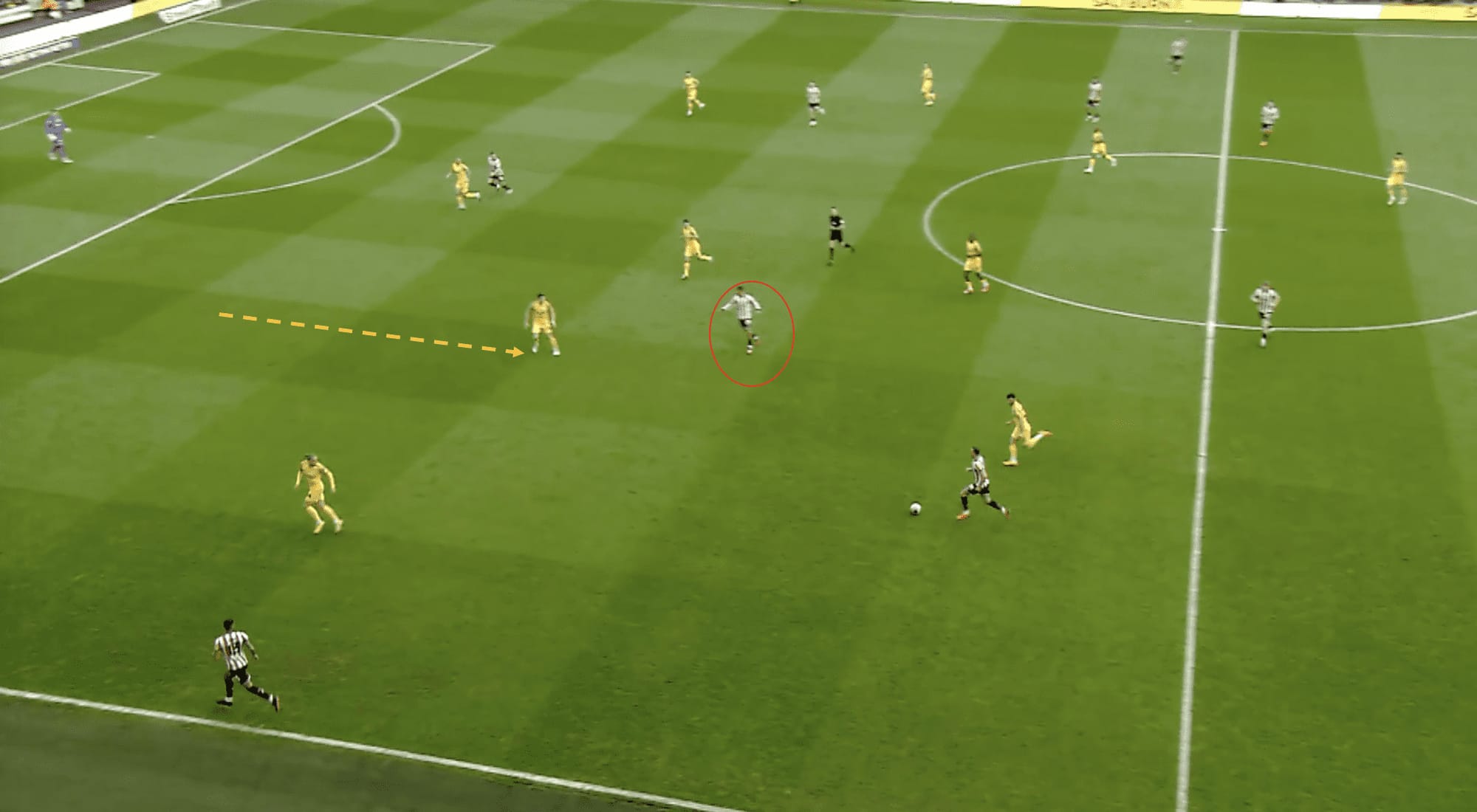
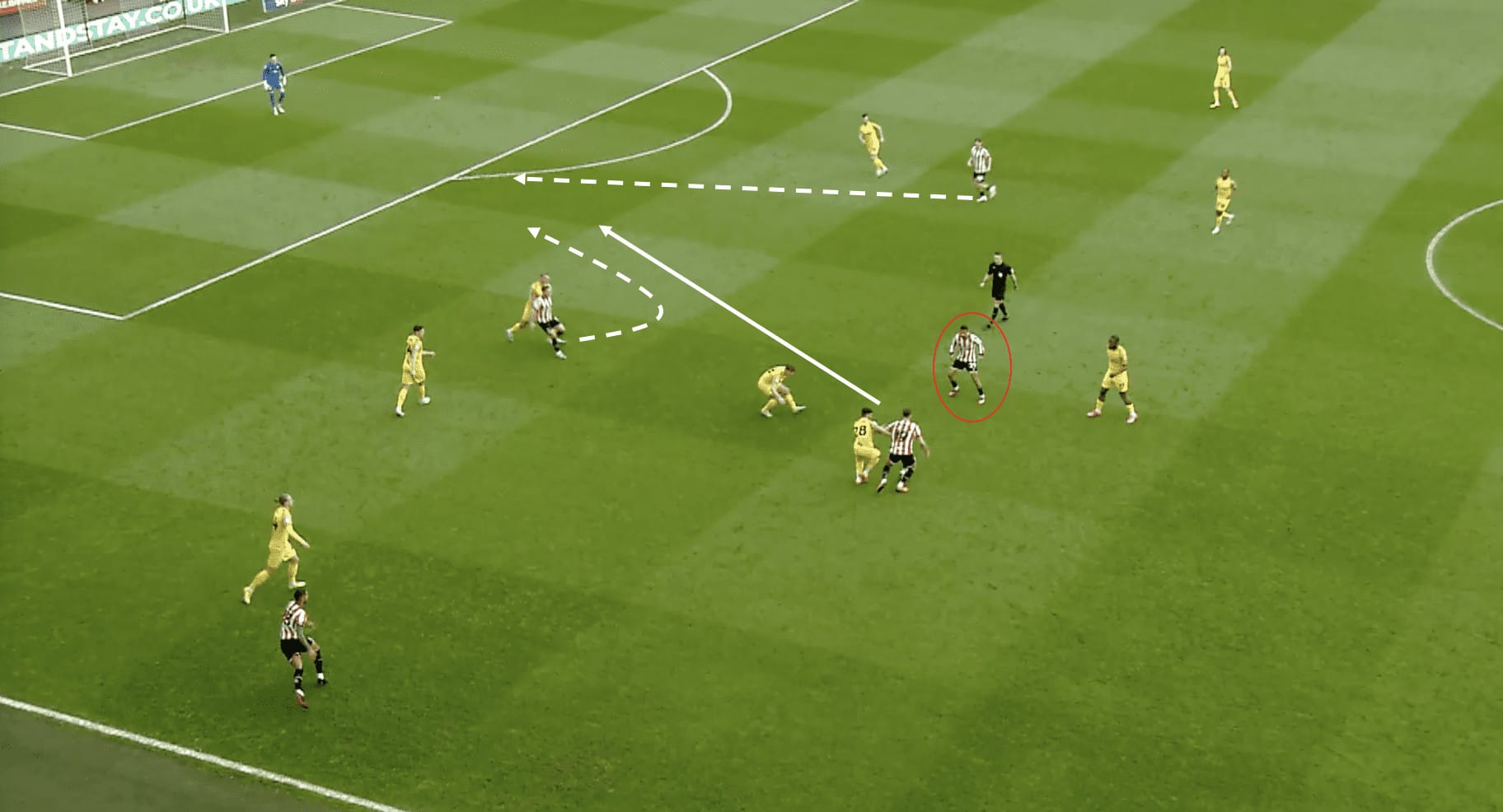
He makes intelligent runs and positions himself strategically, so he can pull defenders out of position, opening up gaps in the opposing defence. This space can be exploited by Ndiaye and his teammates, providing more options for attacking play.
We can see here in the first image that Ndiaye drops deeper, which draws the opposition defender out of his position. As a result, space opens up, which Sheffield United can exploit. Looking at the second image, we can see that Ndiaye drops back even more to make himself available for the short pass. This allows Sheffield United to use him as a decoy; due to the space being opened up by the opposition player, a ball can be played straight through the middle, where two players could potentially run onto it.
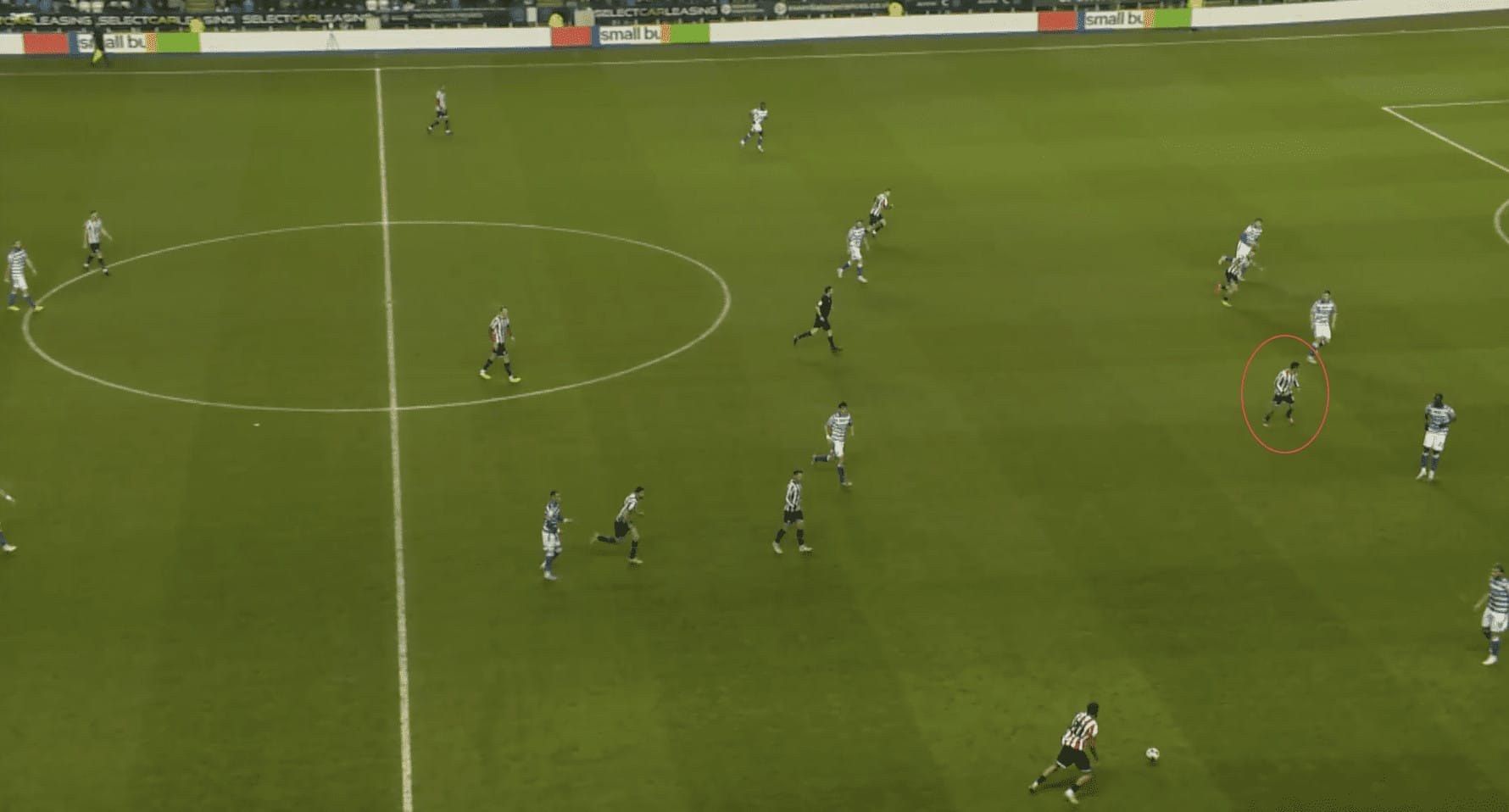
Moreover, good off-the-ball movement helps Ndiaye to identify goalscoring opportunities. By constantly evaluating the positioning of defenders and teammates, he can anticipate potential openings and make timely runs into dangerous areas. This proactive movement increases his chances of being in the right place at the right time to score goals.
We can clearly see in the image above that in this situation, the Senegalese forward is very aware of his surroundings as he is scanning what’s ahead of him, anticipating the run of Oli McBurnie.
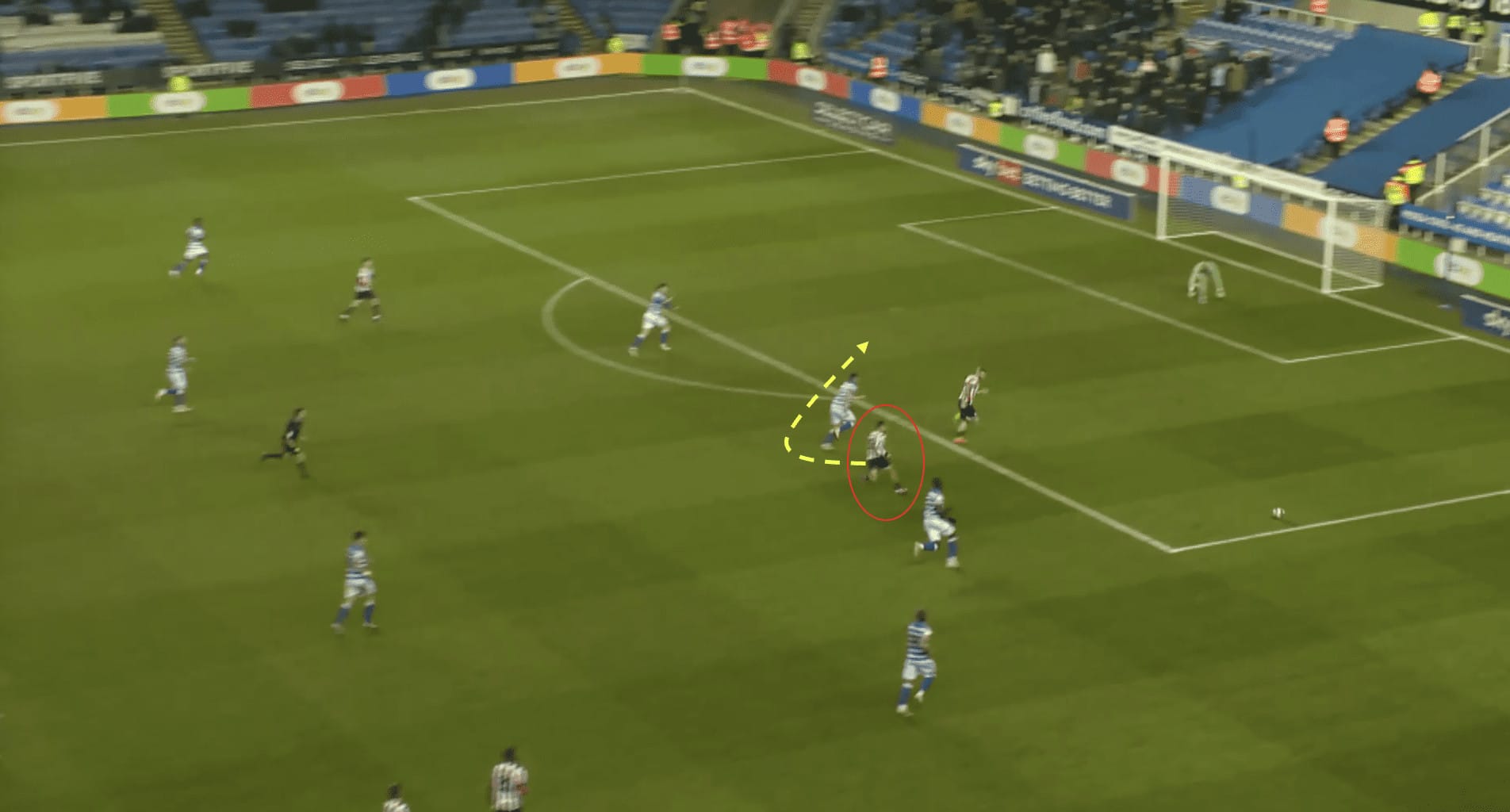
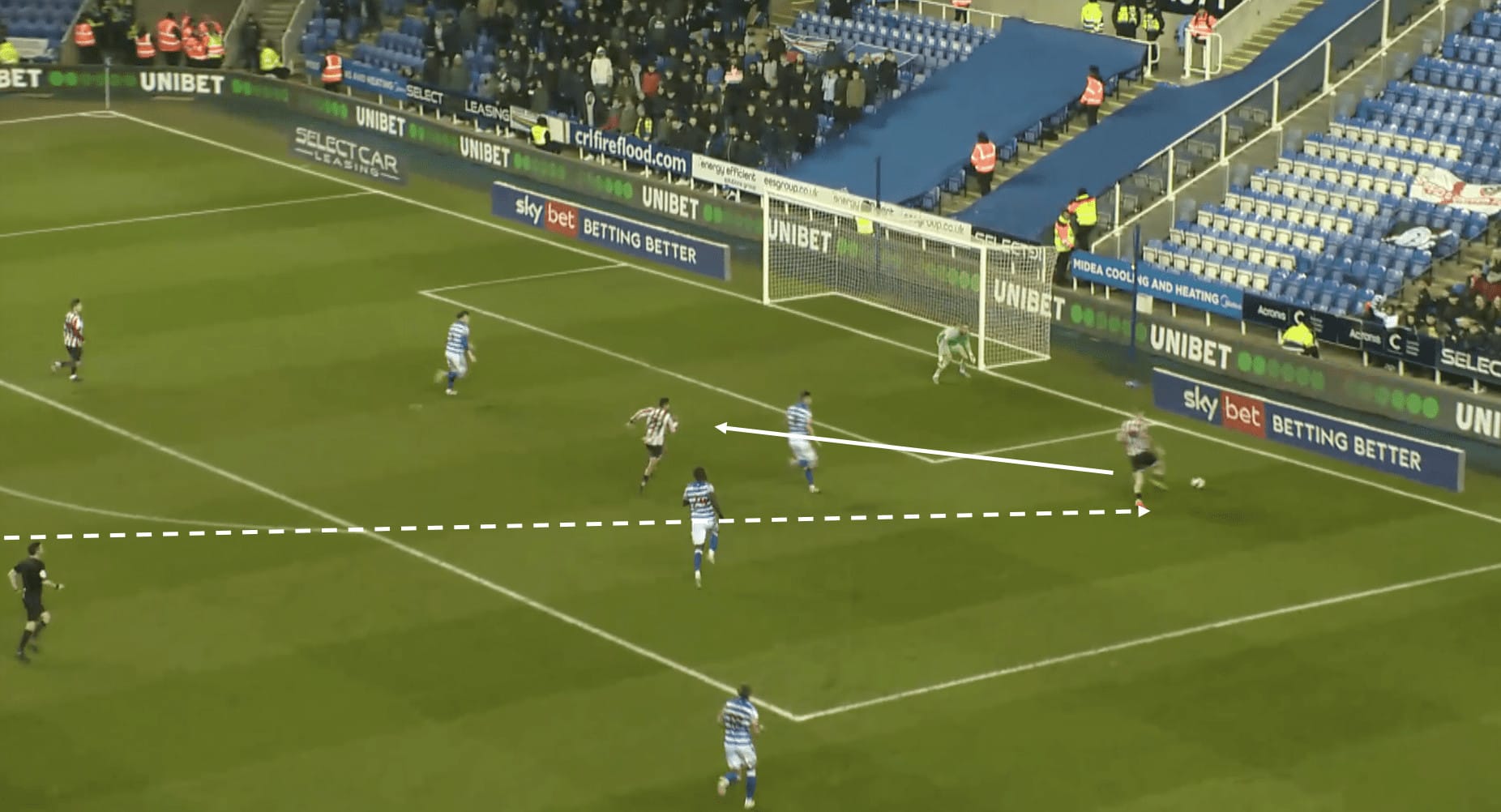
Here, we can see that Ndiaye quickly alters his run as McBurnie makes a diagonal run towards the ball. He uses his agility and body orientation to make a run behind the defender into the penalty area, where he can connect with McBurnie’s cross and turn it goalwards, as shown above.
Defensive work
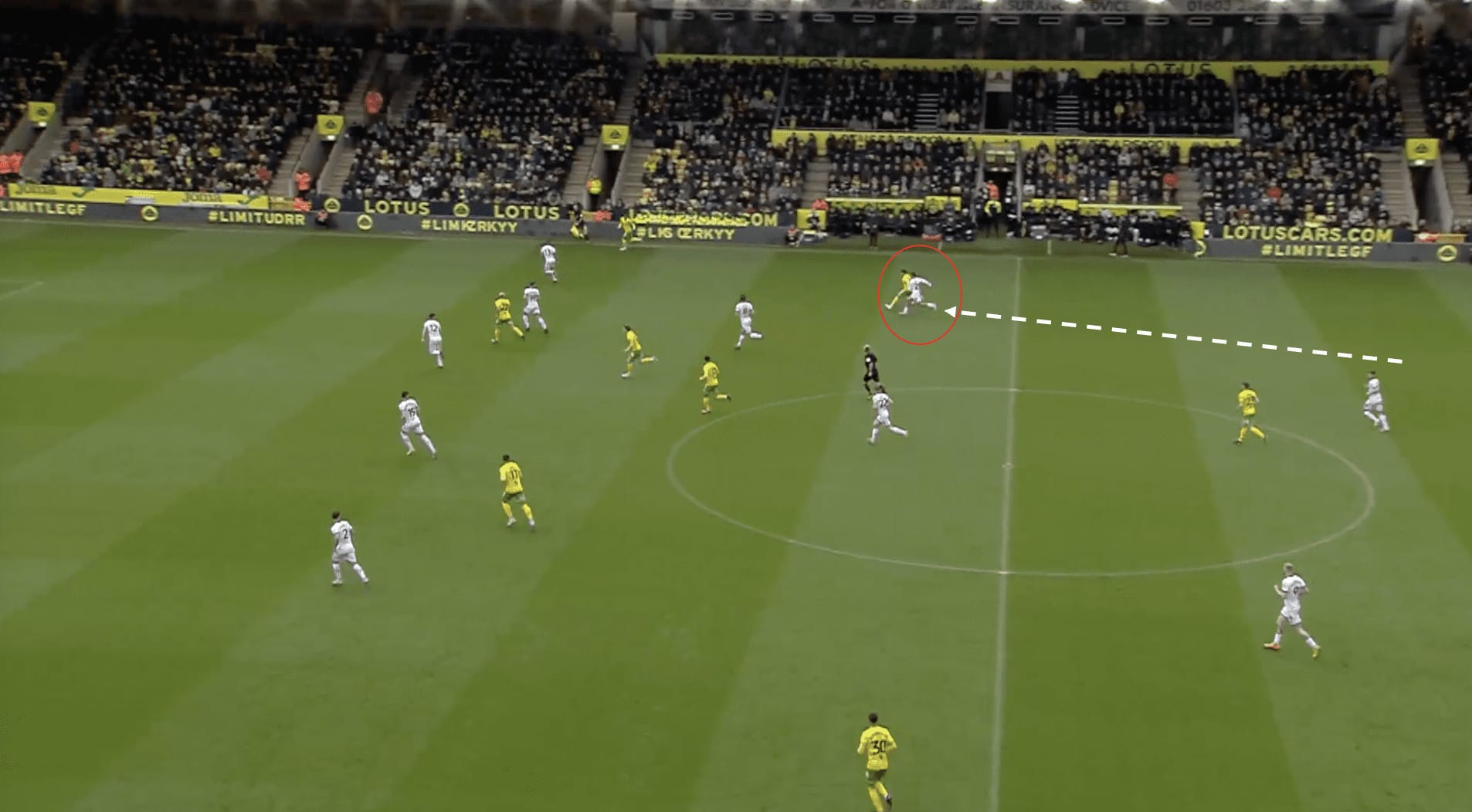
For all of Ndiaye’s attacking prowess, it would be understandable for people to think he doesn’t contribute defensively, but that is not the case. He works tirelessly tracking back, chasing the opposition, looking to regain possession. By tracking back, Ndiaye can disrupt the opposition’s attacks higher up the field. This defensive pressure forces the opposing team to make quicker decisions and can lead to turnovers in dangerous areas. Regaining possession closer to the opponent’s goal increases the forward’s team’s chances of launching immediate counter-attacks and catching the opposition off guard.
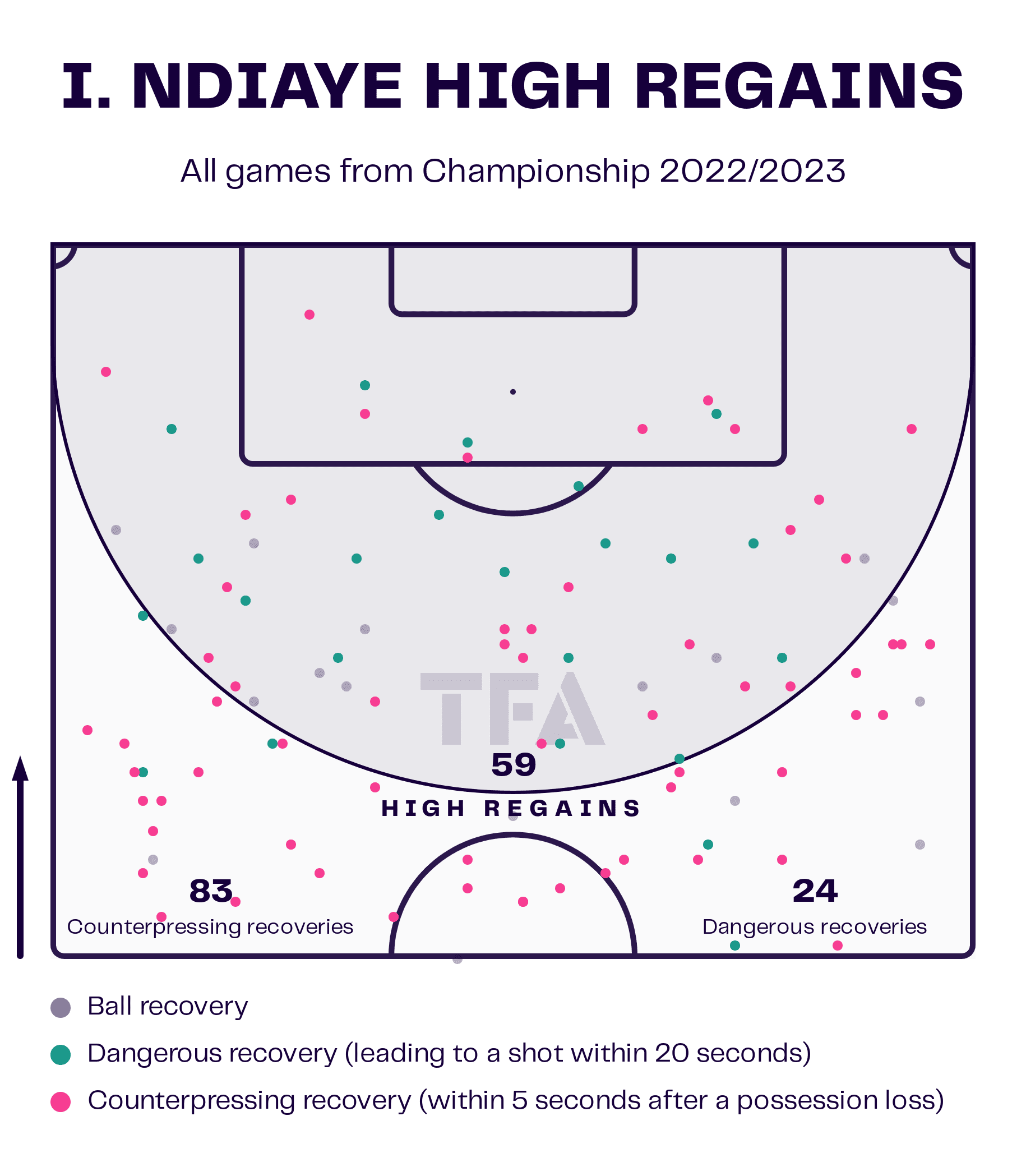
From the data visual above, we can see that Ndiaye contributed 83 counter-pressing recoveries to the team’s cause last season, 59 of which were in the attacking third. We can also see that 24 of those recoveries were ‘dangerous,’ meaning they led to a shot within 20 seconds.
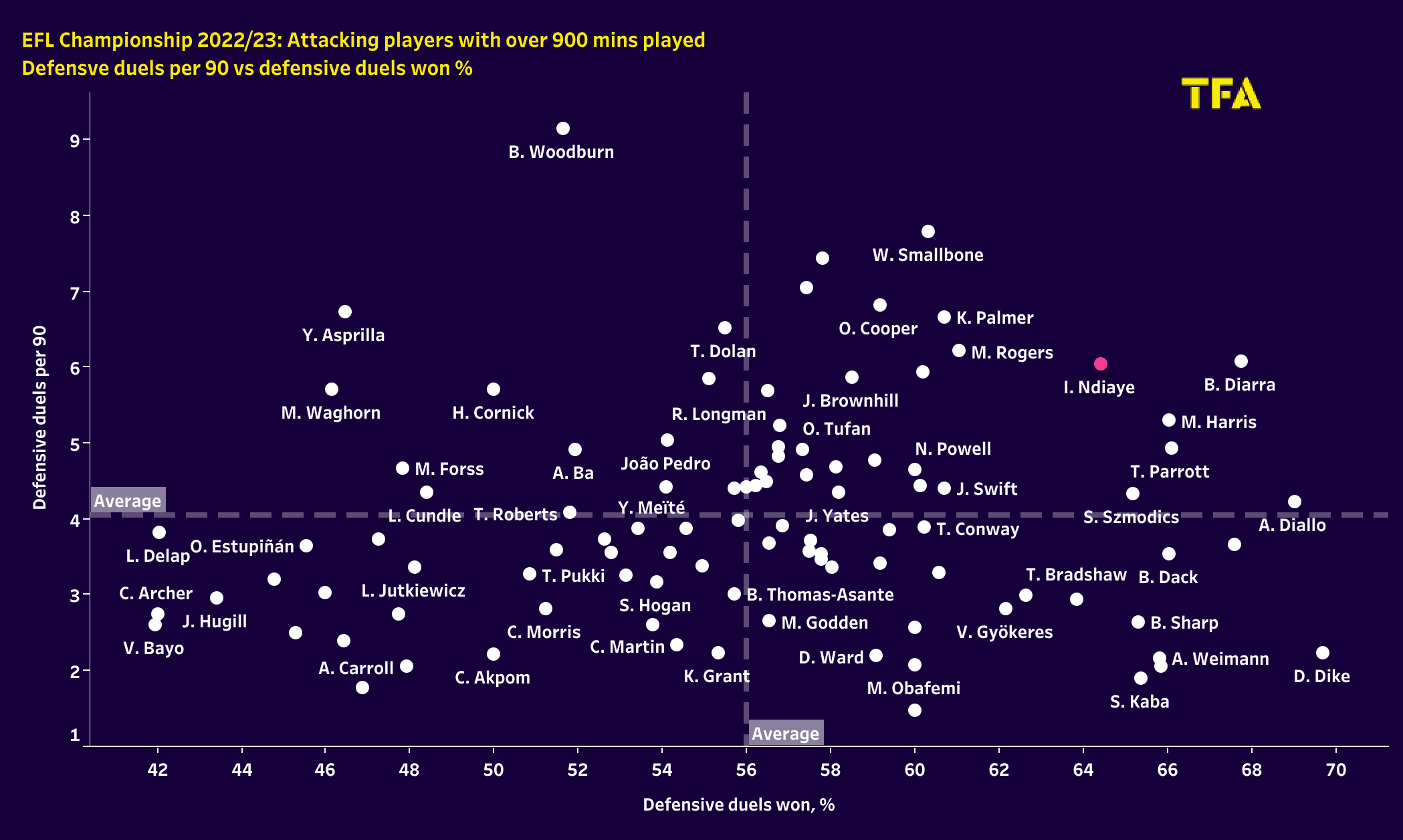
Ndiaye was one of the best-performing attacking players in terms of defensive duels last season. The sought-after forward averaged 6.05 defensive duels per 90 with a win rate of 64.42%. His involvement in defensive duels adds extra defensive pressure on the opposition’s build-up play; by actively pressuring the opposing players, Ndiaye can disrupt their passing rhythm and decision-making, making it harder for them to execute their attacks smoothly.
Additionally, engaging in defensive duels higher up the field is advantageous because it aids in winning back possession in advanced areas. When a forward pressures and challenges the opposition’s defenders or midfielders, it can lead to turnovers close to the opponent’s goal. Winning the ball back in such areas presents the team with immediate attacking opportunities and increases the likelihood of creating goalscoring chances.
Will Ndiaye leave Bramall Lane, and who could replace him?
There has been so much speculation regarding the future of the Sheffield United man throughout the transfer window. Marseille were rumoured to be interested. However, their recent acquisition of Pierre-Emerick Aubameyang could end their alleged pursuit of Ndaiye.
Suppose the Senegalese international doesn’t depart from Bramall Lane this season. In that case, should the Blades fail to retain their Premier League status, his departure will undoubtedly be nailed on for next summer.
Using our xGold tool, we have highlighted a couple of players who share a similar profile to Ndiaye and who may be of interest to Sheffield United should he leave.

The first player xGold suggested is Genk player Bilal El Khannouss; the Moroccan is considered one of the best young players in the Belgian Pro League. The radar above shows us how the two compare; we can see the two are relatively similar in their passing — both players appear to be able to play plenty of dangerous passes per 90 as well as progressive passes.
Of course, the player radars are influenced by how both teams play, so it isn’t surprising to see Ndiaye has far more goal contributions per 90, given his role in the Sheffield United team. Although it has to be said, the likelihood of him wanting to swap Genk for Sheffield United is debatable, so we went back to xGold…

The next best-suggested player is Badredine Bouanani, the OGC Nice youngster who came through the Lille academy and is one of their most exciting prospects since Eden Hazard. Bouanani has enjoyed a breakout season, including making his international debut for Algeria.
From the radar chart, Bouanani appears to like to carry the ball and enjoys plenty of touches in the opposition area. The Nice player also is similar to Ndiaye with his passing and defensive duels won per 90. The youngster is a fascinating player and could actually be an excellent replacement for Ndiaye in a season or so.
Conclusion
Ultimately, if Sheffield United want to retain their Premier League status this season, they will need to keep hold of Iliman Ndiaye. He adds a level of dynamism to the team that would be difficult to replace. Although there have been plenty of rumours swirling regarding Ndiaye’s future, there has been no confirmation that he intends to leave the club despite some firm interest. Whether he stays in the Steel City for one more season or not, it won’t be long until Iliman Ndiaye is playing at the very top level.





Comments